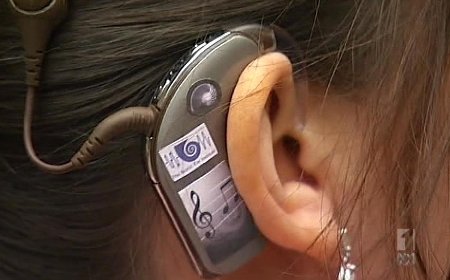
Bionic Ears
It’s not very often that people probably think about how STEM teaching and training has affected their life. But for me I wear a daily reminder of the amazing technology that STEM has produced. On April 17, 2010, the world again became a very noisy place for me. It was the day the bionic device behind my ear, called a cochlear implant, was first turned “on.”
Article Header
« Return to Main PageBionic Ears
It’s not very often that people probably think about how STEM teaching and training has affected their life. But for me I wear a daily reminder of the amazing technology that STEM has produced. On April 17, 2010, the world again became a very noisy place for me. It was the day the bionic device behind my ear, called a cochlear implant, was first turned “on.”
For over twenty years, my hearing had been progressively declining. I could not hear birds sing, crickets chirp, or my young daughter whisper. Hearing aids weren’t enough. I couldn’t even do the simplest things, like having a conversation in a restaurant or talking on the phone. They were nearly impossible.
When I was a child, my ears functioned normally. They faithfully performed the incredible task of translating sound waves into electrical signals, then sending them to my brain. First, the outer ear collected the sounds and directed them to an amplifier in the middle ear. These vibrations then moved to the inner ear, or cochlea, where the biggest miracle occurred. The wiggling of microscopic “hairs” sent a series of electrically charged particles (ions) through molecular-size trapdoors. This stream of electrical impulses traveled up the auditory nerve to the brain.
As I grew older, this intricate system broke down. But the cochlear implant, has bypassed the ear entirely and sends an electrical signal directly to the auditory nerve. The internal portion of the device, implanted under the skin behind the ear, connects to an electrode. The electrode threads through the cochlea and connects directly to auditory nerve fibers.
The external portion, called the processor, sits over the ear and connects to the internal portion via a magnet. Sound is received by the processor and converted to electrical signals. The signals travel through the internal portion to stimulate the auditory nerve. This information is sent to the brain. I think that this step is amazing, because the signals initially arrive as a batch of electrical signals unlike anything the brain has ever received before. But it is able to quickly recognize patterns and interpret the new signals as sound.
Most common sounds, which other people take for granted, I relish hearing. From the turn signal in my car to my daughter’s laughter to crickets chirping, I enjoy hearing every minute of it.
We live in a fallen world and my deafness is a result of that. Scientists will never be able to replicate God’s amazing design and produce “perfect” hearing with a cochlear implant. However, I am extremely thankful for the God-given intelligence of scientists that produced the cochlear implant. STEM teaching and training will help future scientists improve on existing cochlear implants and who knows what other bionic devices may be invented to give people the gift of hearing.
Adapted from “My Bionic Ear,” Answers Magazine (January-March) 2012.








